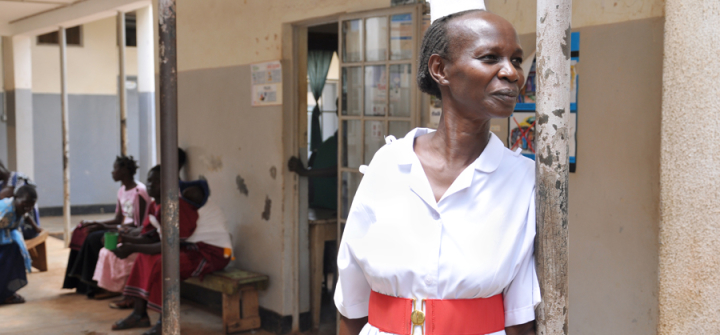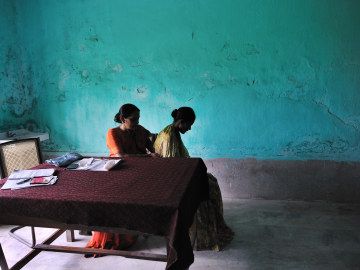A Fighting Chance for Palliative Care
Every year, more than 60 million people worldwide are forced to endure unrelieved pain and suffering—about 2.5 million of them children. They don’t need to.
An October 2017 Lancet Commission report on palliative care not only documented the extent of unrelieved suffering, it also presented possible solutions.
“I view palliative care as a public health issue and a human rights issue,” says Kathleen Foley, MD, an expert on palliative pain relief at Weill Cornell Medical College in New York and a Commission member. Although she has been researching palliative care and pain relief for years, this report is different, she says, because it was conducted not just by pain experts but by health economists set on tackling the vast need for access to palliative care. “This report provides an incredibly important framework [for governments] to analyze suffering in their country, what to do about it, what it costs, how to put that into budget, and what might make it affordable and acceptable,” Foley says. “Unless we have these tools in place, governments won’t have a way to operationalize this service.”
The report lays out an “essential package” of medicines and equipment necessary to meet the basic need for palliative care in low-income countries. At the center of their recommendations: Liquid morphine should be readily available to those suffering with unrelieved pain. “We want basic palliative care to pay for morphine,” Foley says. “This is for patients with severe pain, at the end of life with significant suffering or maybe an acute severe problem such as burns. This is specifically palliative care, with a focus on those who might live a year or less.”
In poor countries, the need is great, Foley says. “In Africa, every day we see the extreme toll of unrelieved suffering, and when access to medicine is available, we see dramatic differences.”
Some may worry that the recommendation of increasing access to opioids worldwide will result in a US-style opioid addiction epidemic. However, Foley says those fears are unfounded. “This model of palliative care is not associated with the misuse of drugs. We have data in the US that up to about [the year] 2000, as opioids were increasingly available to treat cancer pain, there is no evidence that medications drifted into the substance-use population.” Later, she says, more complicated factors contributed to the crisis we see today.
An important part of the Commission’s strategy is to train all those involved—physicians, nurses, clergy—in the safe use of opioids, and using electronic records to track opioid use. And unlike in the US, opioids would not be marketed directly to patients or physicians. “We can be safe and effective if this is done in a strategic fashion,” Foley says.
Another key step to improving access to palliative care will be to increase awareness, says Emmanuel Luyirika, MD, director of the African Palliative Care Association in Uganda. “There is a lack of information about palliative care, especially for policy makers and stakeholders, including to the level of the ministers of health. That lack of awareness about palliative care creates a disincentive to invest in the discipline,” Luyirika says.
Patients need to advocate for palliative care, he says. “Awareness is one of our major objectives, at every level—the patient, family, community, and health workers. When people are aware, they can demand the service and use it. We have a long way to go,” Luyirika says.
WHO and other international organizations can help put pressure on governments to provide palliative care. “The challenge now is to ensure awareness across the globe, from Geneva to country offices, and support national ministries of health to integrate it. Just like [WHO] pushed for immunization and control of disease, they can also push for palliative care,” says Luyirika.
Of course, integrating palliative care into health systems will require funding. According to the report, the recommended essential package of medicines and equipment in low-income countries will cost governments an estimated $2.16 per person annually. In lower-middle-income countries, the cost is estimated at just 78 cents per capita, using the world’s lowest available drug prices.
However, the current costs may be much higher because poorer countries often pay many times more for cheap, off-label morphine than high-income countries do. One solution is to lower the cost by banding together. “We encourage countries to purchase en masse,” says Felicia Knaul, PhD, a health economist at the University of Miami. “If a [pharmaceutical] company has a market for a thousand doses, they can use economies of scale and produce it. That [demand] stabilizes the market by bringing countries together,” she says.
Another option is for countries to produce the medicine themselves. Countries can buy a cheap form of morphine powder from a number of sources internationally and turn it into liquid doses. “By reconstituting liquid oral morphine, it cuts out the pharma industry,” Luyirika says. “It’s quite cheap, it’s not open to misuse, not injectable, it doesn’t get people high. It’s appropriate for patients,” Luyirika says. Setting up production is “an uphill task; you need to buy equipment, train people, support the procurement system, estimate and make what’s needed. But it’s a good model, and it’s working in Uganda, Kenya and Swaziland.”
Following on the success of its morphine-production program, the Ugandan government also created clear policies to make morphine more available in hospice settings, even allowing nurses to prescribe and administer it after receiving 9 months of palliative care training. Locally produced morphine is now available throughout the public health system in Uganda. Recently Swaziland, Kenya, Rwanda, Nigeria and Malawi have followed suit, adopting the Ugandan model of liquid morphine production and distribution.
When it comes to bringing relief to the suffering, Knaul says, education is the key. “Every [health care worker] should be given training in palliative care, because you’re going to see dying, you’re going to see pain. It has to be part of medical education to give [providers] a fighting chance to do this right.”
This is part III of a GHN exclusive 3-part series, A World in Agony: The Global Need for Pain Treatment. Read Part I, Palliative Pain Relief Woefully Inadequate Worldwide, here, and Part II, Opiophobia and High Costs: Untangling the Barriers to Palliative Care, here.
Join the tens of thousands of subscribers who rely on Global Health NOW summaries and exclusive articles for the latest public health news. Sign up for our free weekday enewsletter, and please share the link with friends and colleagues: http://www.globalhealthnow.org/subscribe.html
Mary Philomena Okello, clinical palliative nursing officer at Lira Regional Referral Hospital in Lira, Uganda, stands outside the ward. © 2009 Carol Bales/IntraHealth International, Courtesy of Photoshare




